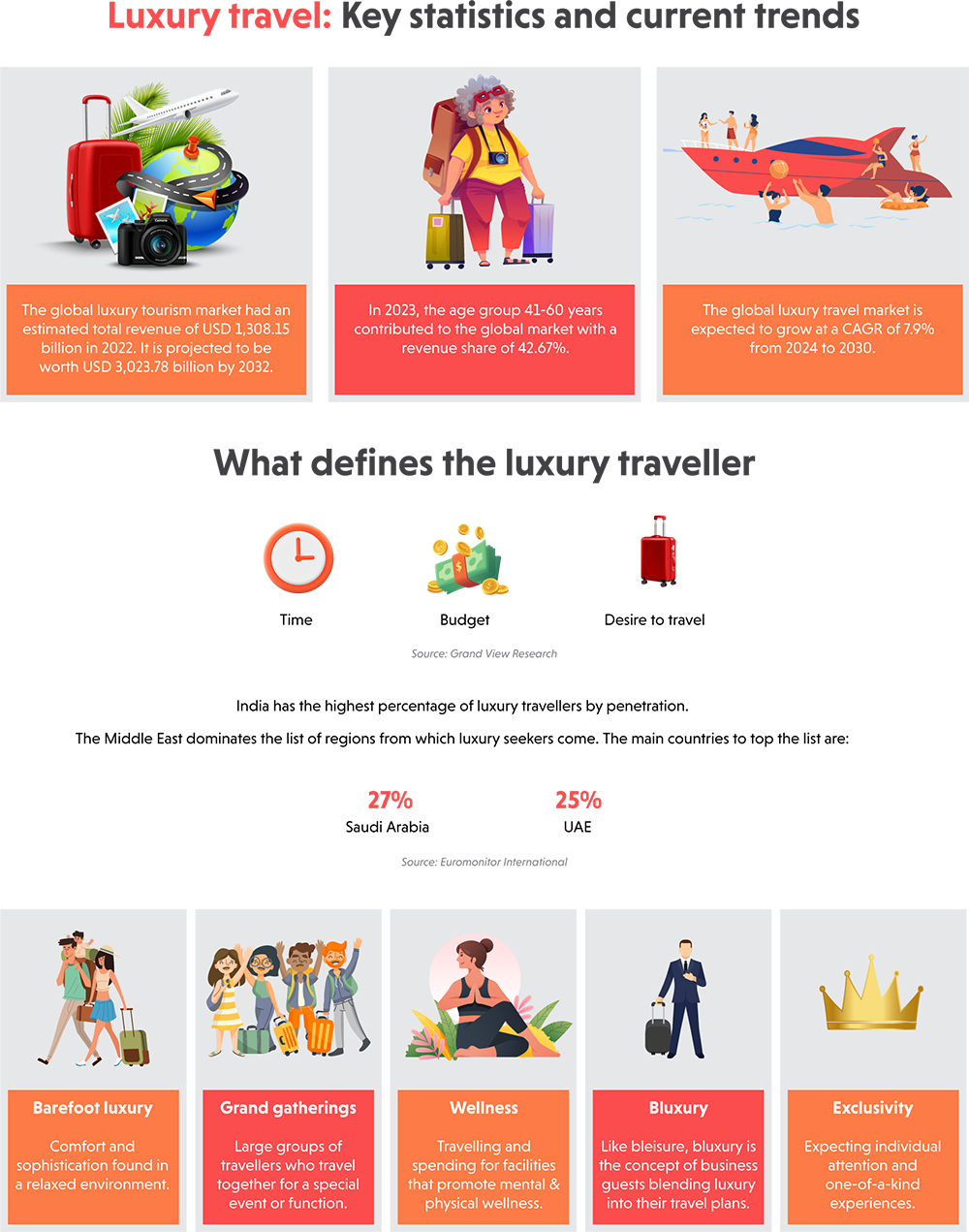
Who is the luxury traveller?
Contrary to popular belief, luxury travellers do not always mean “wealthy travellers.” For each group, luxury means a different experience.
- Aspiring luxury: Often millennials, they are known for being digital savvy and their quest for unique, culturally immersive experiences. They love novelty, culture, history, and authentic experiences, as highlighted in a 2024 McKinsey State of Tourism Survey.
- Absolute luxury: Absolute luxury is sought out by a small percentage of travellers with disposable income, who often fall under the baby boomer label and are considered high-net-worth individuals. Their idea of luxury extends to extravagant experiences defined by opulence and careful curation.
Opportunities in the luxury travel market
Consumer behaviour trends in luxury tourism open new avenues for hospitality service providers.
1. Offering exclusivity
Those seeking barefoot luxury, which allows complete relaxation, prefer an exclusive “VIP” treatment that makes them feel like royalty. This treatment starts before the guest arrival and last throughout the stay; the hotel reaching out to guests with targeted websites that adapt to their language, targeted social media content, pre-stay questionnaires to record preferences, in-room services and guest servicing systems during the stay, post-stay feedback forms and finally, post-stay engagement messages.
Getting to know key details about the guests, catering to their needs, and maintaining an excellent post-stay guest relationship can make the guests feel valued and taken care of. Businesses further enhance the experience with room customisation, mobile-controlled in-room technology, smart guest engagement applications or in-room tablets. Luxury translates to absolute convenience; where the guest does not have to move at all to request a new towel to the room or adjust the room temperature.
2. Photogenic moments
Most modern travel and experience cultures are defined by Instagrammable moments. Ensuring a destination or an experience is ‘Instagrammable’ may not always be easy, but this is where guest data can come in. Looking at consolidated guest data and reports on a hotel’s ERP system to understand what guests love most about a property gives brands the foundation to work on selling the right experience. As social media becomes an important channel to communicate and connect with audiences, it is also encouraged to enhance guest-preferred experiences and highlight them on a brand’s official social network pages.
Hilton remains one of the best hospitality brands that have successfully implemented this strategy, highlighting the experiences exclusive to their brand on their social media. One such experience was rooms inspired by last year’s blockbuster success Barbie (at Hilton Bogota Corferias). The Aladdin suite (Hilton New York Times Square), complemented by tickets to the Broadway production of the story, is another example from the same group, promising and delivering the ideal Instagrammable moments that are popular during specific times of the year.
3. Branded experiences
Consumption of branded goods and services has always been a marker of luxury, and this is particularly popular among aspiring luxury travellers who use branding to validate their sense of luxury. This leaves an opportunity for hotel brands to explore. For example, offering branded products or services priced for the segment of aspiring luxury travellers, such as affordable amenities at luxury destinations. These types of branded experiences also extend to experiencing branded lifestyles within luxury resorts.
Branded experiences can come from outside the sphere of hospitality, where the industry partners with luxury lifestyle or fashion brands. For example, at the Beverly Hills Hotel in Los Angeles, visitors can shop for a limited-edition Dioriviera capsule collection. Beyond partnerships, a new trend in the market is luxury brands—lifestyle, fashion, automative etc.—expanding their offerings into hospitality and exploring their opportunity within the markets. The Bentley Residences in Miami and the Bulgari Resort in Dubai are some of the renowned properties maintained by these brands.
4. Diversified offerings
Diversification in the luxury market entails understanding the audience’s multigenerational nature and their spending capacity, a fact that was considered during Shangri-La’s multigenerational strategy. The Group’s launch of the Shangri-La’s family experience brand Fam.ily™ will create experiences for multigenerational families, even providing guests the support for their parenting journeys. According to Kuok Hui Kwong, chair of Shangri-La, there is a rise of a new generation of luxury consumers who wants to share experiences and quality moments with their families.
Other diversified offerings include out-of-the-box amenities that include more than just plush rooms. Instead, think of cooking classes with celebrity chefs, private wine tastings, or VIP access to cultural events—an easier feat to accomplish if the hotel leverages its guest data system and loyalty programs right.
Creating opulence takes effort
The idea of luxury goes beyond simple offerings of having a personal butler. It is a segment defined by what defines most of the modern travellers, experience. Brands that tap into this market need to be crafty with their offerings, understand the preference of each segment, and provide exclusive offers created through the right combination of technology, marketing, partnerships, and personalisation.

